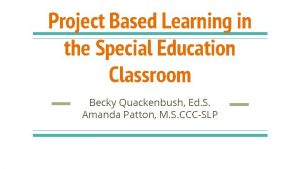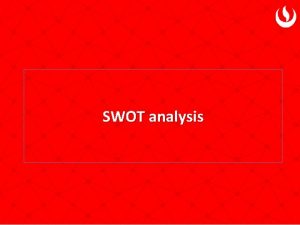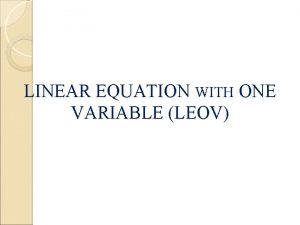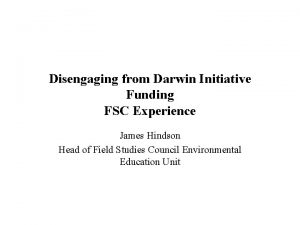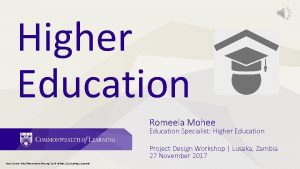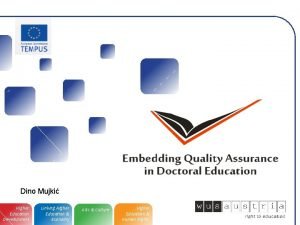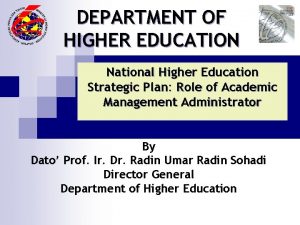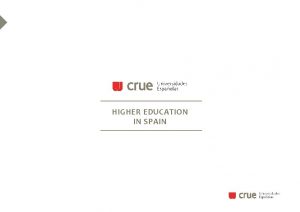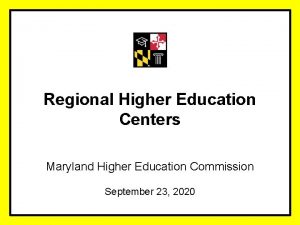Learning Outcomes Disengaging Students in Higher Education OISE
![Learning Outcomes [Dis]engaging Students in Higher Education OISE – September 24, 2012 Nicola Simmons, Learning Outcomes [Dis]engaging Students in Higher Education OISE – September 24, 2012 Nicola Simmons,](https://slidetodoc.com/presentation_image/5d71f90821ea792417fee22bd8fbea71/image-1.jpg)


![Or Disengagement? O Caine and Caine (1998) suggest that “prespecified ‘correct’ outcomes [that] have Or Disengagement? O Caine and Caine (1998) suggest that “prespecified ‘correct’ outcomes [that] have](https://slidetodoc.com/presentation_image/5d71f90821ea792417fee22bd8fbea71/image-4.jpg)









- Slides: 13
![Learning Outcomes Disengaging Students in Higher Education OISE September 24 2012 Nicola Simmons Learning Outcomes [Dis]engaging Students in Higher Education OISE – September 24, 2012 Nicola Simmons,](https://slidetodoc.com/presentation_image/5d71f90821ea792417fee22bd8fbea71/image-1.jpg)
Learning Outcomes [Dis]engaging Students in Higher Education OISE – September 24, 2012 Nicola Simmons, Ph. D. Department of Graduate and Undergraduate Studies in Education, Brock University Nicola. Simmons@brocku. ca

Learning Outcomes O Make the instructor’s implicit expectations explicit O Clarify students’ responsibilities O Align course outcomes, tasks, assessments O “Facilitate credit transfers, admission to graduate program, and accreditation of professional programs” (Hubball, Gold, Mighty, & Britnell, 2007, p. 93). O Facilitate conversations at the department level about what is being taught and why 2

Learning Engagement? O “When there is a high level of specification of learning outcomes and a high level of alignment of goals, assessment and criteria, students’ experience is characterized by: O Less coverage of the syllabus O Experience of less and poorer quality feedback O Less experience of ‘appropriate assessment’ O Less experience of ‘clear goals and standards’ O Less deep approach” (Gibbs, 2010) 3
![Or Disengagement O Caine and Caine 1998 suggest that prespecified correct outcomes that have Or Disengagement? O Caine and Caine (1998) suggest that “prespecified ‘correct’ outcomes [that] have](https://slidetodoc.com/presentation_image/5d71f90821ea792417fee22bd8fbea71/image-4.jpg)
Or Disengagement? O Caine and Caine (1998) suggest that “prespecified ‘correct’ outcomes [that] have been established by an external agent” (p. 5) is one of a set of five conditions that result in cognitive downshifting, in which students disengage from the learning process and curriculum. O Outcomes-based education can run the risk of emphasizing the accumulation of discrete items of content rather than the meta-cognitive and transdisciplinary thinking and problem-solving required of current and future graduates. 4

Some Challenges O Often focus on content and assessment not process of O O O learning Focus on competencies rather than competence (Sadler, 2007); may lead to standardized testing May be more meaningful to instructor than students Challenging for most faculty to write (Rust, Price, & O’Donavan, 2003); particularly for the affective domain. Behavioural engagement is easier to see than cognitive and psychological engagement An instrumental process, or what Schön (1983) refers to as a techno-rational perspective, rather than a negotiated process that could lead to transformative learning Little room for discovery; may reduce learning from an aesthetic experience to one that is so constrained as to be anaesthetic (Robinson, 2010) 5

Quality Improvement Efforts “Tend to be compromised to some extent by quality seen as an aspect of accountability or of standardsetting. Increasingly, internal quality management is complemented by external quality-assurance mechanisms, complete with quantifiable indicators, that reflect a considerable loss of public trust in education” (Kehm, 2010, p. 42). Which then leads to more accountability measures… 6

Quality Improvement Efforts “Quality assurance and enhancement are based in quality paradigms that are philosophically opposed. Since accountability is the main driving force behind quality assurance in higher education, the primary goals of quality assurance processes are to monitor and maintain quality. As a result, quality assurance processes tend to inhibit innovation in teaching and learning rather than advance it” (Nicholson, 2011, p. 8). 7

Pedagogical Processes O “Wide assumption that systemic course design is ‘a good thing’; Oxford does not use anything resembling systematic course design …. What is salient is the process, and its rationale, not the goals” (Gibbs, 2010) O Over two thirds of exemplary teachers in one study made changes in their teaching while it was in progress, taking advantage of teachable moments rather than remaining within the confines of their plans for content delivery (Mc. Alpine & colleagues, as cited in Entwistle, Skinner, Entwistle, & Orr, 2000). O This kind of reflection-in-action (Schön, 1983) places an emphasis strongly on the process of learning rather than outcomes. 8

Student Driven Approaches O “Involving students in the design of assessment, choice of assessment task and negotiation of criteria” (Gibbs, 1992, p. 7) can result in higher levels of student engagement. O Outcomes should be written in terms of personal understanding (from Biggs, 1999) rather than target understanding (Entwistle & Smith, cited in Entwistle, 2000). 9

Learning without Outcomes? O “Learners were allowed to identify, seek, and master knowledge that was personally relevant instead of simply having to receive pre-determined curricular information. . As a result new learning was practically applicable” (participant quote, Simmons, 2011). O “I was able to see the value once I moved beyond the frozen fear of uncertainty to ask myself “What did I want to gain from this course? How did I learn when pushed out of my comfort zone? ” I had to be transformed into a student who was open to this new concept and new territory for learning …. [where] mistakes … would not be judged but instead used as stepping stones toward learning” (participant quote, Simmons, 2011). 10

Discussion Questions O How can the commodification of education and accompanying specification of discrete chunks to be learned prepare students for the complex (and transdisciplinary) challenges of today’s society? O Whose agenda is privileged by outcomes? O “If learning outcomes are so practical and useful, why is there this resistance? ” (Hussey & Smith, 2002, p. 224). 11

References O O O O Caine, R. N. , & Caine, G. (1998, May). Building a bridge between the neurosciences and education: Cautions and possibilities. Bulletin, 1 -8. Entwistle, N. (2000). Promoting deep learning through teaching and assessment: Conceptual frameworks and educational contexts. Paper presented at TLRP conference, Leicester, UK, November. Entwistle, N. , Skinner, D. , Entwistle, D. , & Orr, D. (2000). Conceptions and beliefs about ‘good teaching’: An integration of contrasting research areas. Higher Education Research & Development, 19(1), 5 -26. Gibbs, G. (2010). The importance of context in understanding teaching and learning: Reflections on thirty five years of pedagogic research. Keynote at the International Society for Scholarship in Teaching and Learning annual conference, Birmingham, UK, October. Gibbs, G. (1992). Improving the quality of student learning. Bristol, England: TES. Hubball, H. , Gold, N. , Mighty, J. , & Britnell, J. (2007). Supporting the implementation of externally generated learning outcomes and learning-centred curriculum development: An integrated framework. New Directions for Teaching and Learning, 112, 93 -105. Hussey, T. , & Smith, P. (2002). The trouble with learning outcomes. Active Learning in Higher Education, 3(3), 220 -233. 12

References O O O O Kehm, B. (2010). European education: The influence of the Bologna process. Change: the magazine of higher education, 42(3), 40 -46. Nicholson, K. (2011). Quality assurance in higher education: A review of the literature. Available online at http: //cll. mcmaster. ca/COU/pdf/Quality%20 Assurance%20 Literature%20 Review. pdf Robinson, K. (2010). Changing education paradigms. London: RSAnimate. Available online at http: //www. youtube. com/watch? v=z. DZFc. DGp. L 4 U. Rust, C. , Price, M. , & O’Donovan, B. (2003). Improving students’ learning by developing their understanding of assessment criteria and processes. Assessment & Evaluation in Higher Education, 28(2), 147 -164. Sadler, D. R. (2007). Perils in the meticulous specification of goals and assessment criteria. Assessment in Education, 14(3), 387 -392. Schön, D. (1983). The reflective practitioner. New York: Basic Books. Scouller, K. (1998). The influence of assessment method on students’ learning approaches: Multiple choice question examination versus assignment essay. Higher Education, 35, 453 -472. Simmons, N. , Barnard, M. , & Fennema, W. (2011). Learning without limits: Perspectives on participatory pedagogy. Collected Essays on Learning and Teaching, 4. 13
 Jp racing oise
Jp racing oise Nsf oise
Nsf oise Project based learning for special education
Project based learning for special education Obe in education
Obe in education Learning outcomes example
Learning outcomes example Water cycle learning outcomes
Water cycle learning outcomes Lesson plan of notice writing
Lesson plan of notice writing Objective of swot
Objective of swot Objective of rhymes
Objective of rhymes Planning goals and learning outcomes
Planning goals and learning outcomes What is photolysis in photosynthesis
What is photolysis in photosynthesis Learning objectives of nutrition in plants class 7
Learning objectives of nutrition in plants class 7 What is nc bts
What is nc bts Leov math
Leov math


